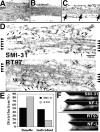Neurofilaments consist of distinct populations that can be distinguished by C-terminal phosphorylation, bundling, and axonal transport rate in growing axonal neurites
- PMID: 11264295
- PMCID: PMC6762414
- DOI: 10.1523/JNEUROSCI.21-07-02195.2001
Neurofilaments consist of distinct populations that can be distinguished by C-terminal phosphorylation, bundling, and axonal transport rate in growing axonal neurites
Abstract
We examined the steady-state distribution and axonal transport of neurofilament (NF) subunits within growing axonal neurites of NB2a/d1 cells. Ultrastructural analyses demonstrated a longitudinally oriented "bundle" of closely apposed NFs that was surrounded by more widely spaced individual NFs. NF bundles were recovered during fractionation and could be isolated from individual NFs by sedimentation through sucrose. Immunoreactivity toward the restrictive C-terminal phospho-dependent antibody RT97 was significantly more prominent on bundled than on individual NFs. Microinjected biotinylated NF subunits, GFP-tagged NF subunits expressed after transfection, and radiolabeled endogenous subunits all associated with individual NFs before they associated with bundled NFs. Biotinylated and GFP-tagged NF subunits did not accumulate uniformly along bundled NFs; they initially appeared within the proximal portion of the NF bundle and only subsequently were observed along the entire length of bundled NFs. These findings demonstrate that axonal NFs are not homogeneous but, rather, consist of distinct populations. One of these is characterized by less extensive C-terminal phosphorylation and a relative lack of NF-NF interactions. The other is characterized by more extensive C-terminal NF phosphorylation and increased NF-NF interactions and either undergoes markedly slower axonal transport or does not transport and undergoes turnover via subunit and/or filament exchange with individual NFs. Inhibition of phosphatase activities increased NF-NF interactions within living cells. These findings collectively suggest that C-terminal phosphorylation and NF-NF interactions are responsible for slowing NF axonal transport.
Figures








Similar articles
-
Neurofilament cross-bridging competes with kinesin-dependent association of neurofilaments with microtubules.J Cell Sci. 2009 Oct 1;122(Pt 19):3579-86. doi: 10.1242/jcs.051318. Epub 2009 Sep 8. J Cell Sci. 2009. PMID: 19737816
-
Dynein mediates retrograde neurofilament transport within axons and anterograde delivery of NFs from perikarya into axons: regulation by multiple phosphorylation events.Cell Motil Cytoskeleton. 2006 May;63(5):266-86. doi: 10.1002/cm.20122. Cell Motil Cytoskeleton. 2006. PMID: 16570247
-
Assembly and turnover of neurofilaments in growing axonal neurites.Biol Open. 2018 Jan 26;7(1):bio028795. doi: 10.1242/bio.028795. Biol Open. 2018. PMID: 29158321 Free PMC article.
-
Neurofilaments in health and disease.Med Electron Microsc. 2000;33(4):173-99. doi: 10.1007/s007950000019. Med Electron Microsc. 2000. PMID: 11810476 Review.
-
Organizational dynamics, functions, and pathobiological dysfunctions of neurofilaments.Results Probl Cell Differ. 2009;48:29-45. doi: 10.1007/400_2009_8. Results Probl Cell Differ. 2009. PMID: 19554281 Review.
Cited by
-
Defective neurofilament transport in mouse models of amyotrophic lateral sclerosis: a review.Neurochem Res. 2003 Jul;28(7):1041-7. doi: 10.1023/a:1023259207015. Neurochem Res. 2003. PMID: 12737529 Review.
-
Cyclin-dependent kinase 5 prevents neuronal apoptosis by negative regulation of c-Jun N-terminal kinase 3.EMBO J. 2002 Feb 1;21(3):324-33. doi: 10.1093/emboj/21.3.324. EMBO J. 2002. PMID: 11823425 Free PMC article.
-
Local regulation of neurofilament transport by myelinating cells.J Neurosci. 2014 Feb 19;34(8):2979-88. doi: 10.1523/JNEUROSCI.4502-13.2014. J Neurosci. 2014. PMID: 24553938 Free PMC article.
-
Neurofilament transport is dependent on actin and myosin.J Neurosci. 2004 Oct 27;24(43):9486-96. doi: 10.1523/JNEUROSCI.1665-04.2004. J Neurosci. 2004. PMID: 15509735 Free PMC article.
-
Prognostic value of serum neurofilaments in patients with clinically isolated syndromes.Neurology. 2019 Feb 12;92(7):e733-e741. doi: 10.1212/WNL.0000000000006902. Epub 2019 Jan 11. Neurology. 2019. PMID: 30635483 Free PMC article.
References
-
- Anderton BH, Breinburg D, Downes MJ, Green PJ, Tomlinson BE, Ulrich J, Wood JN, Kahn J. Monoclonal antibodies show that neurofibrillary tangles and neurofilaments share antigenic determinants. Nature. 1982;298:84–86. - PubMed
-
- Baas PW, Brown A. Slow axonal transport: the polymer transport model. Trends Cell Biol. 1997;7:380–384. - PubMed
-
- Brady ST. Motor neurons and neurofilaments in sickness and health. Cell. 1993;73:1–3. - PubMed
-
- Brown AT. Visualization of single neurofilaments by immunofluo-rescence microscopy of splayed axonal cytoskeletons. Cell Motil Cytoskeleton. 1997;38:133–145. - PubMed
-
- Brown AT. Contiguous phosphorylated and nonphosphorylated domains along axonal neurofilaments. J Cell Sci. 1998;111:455–467. - PubMed
Publication types
MeSH terms
Substances
LinkOut - more resources
Full Text Sources
